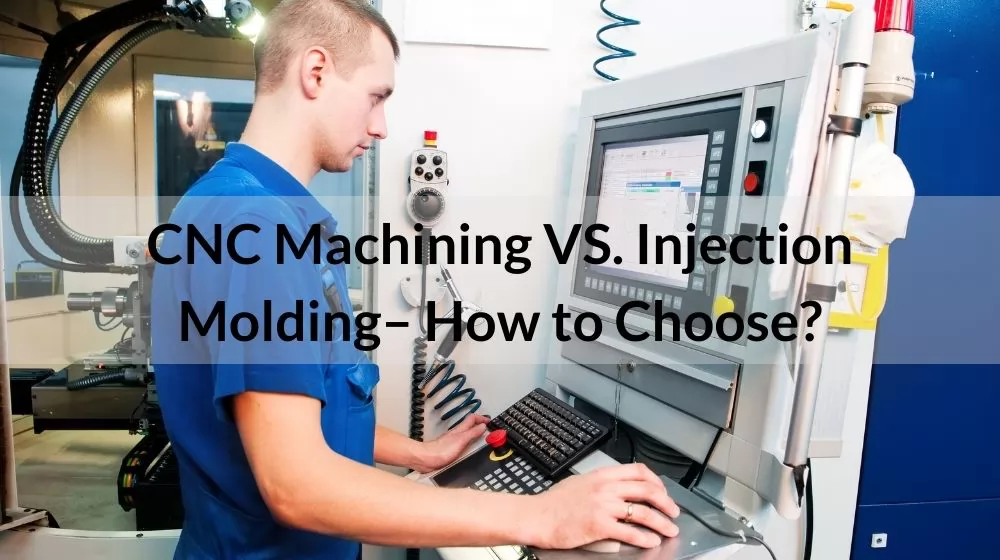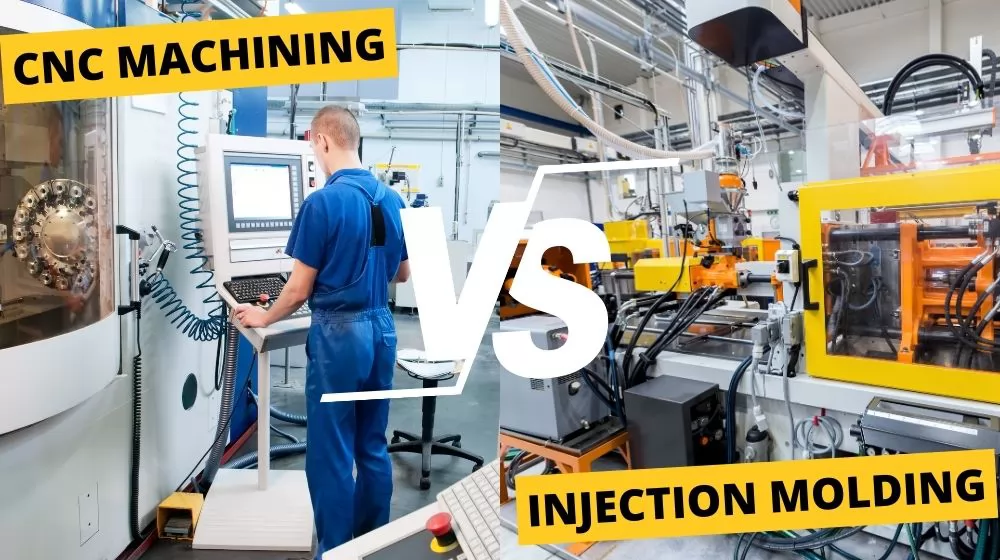
CNC machining is closely linked to the molding process, so many companies that provide plastic injection molding services have relied heavily on CNC machining for a variety of reasons. CNC machining has been successfully used in manufacturing for many years and is now extending its influence into injection molding.
We’ll take an in-depth look at how CNC machining is used in injection molding, the many benefits it brings to the process, the challenges of combining both, and their place in the future of manufacturing. The organic combination of the two not only represents the forefront of manufacturing technology, but also lays a solid foundation for improving production efficiency, improving product quality and promoting manufacturing innovation.
Table of Contents
- What is plastic injection molding?
- What is CNC machining?
- Definition of CNC machining and comparison to injection molding
- What are the advantages of CNC machining compared to injection molding?
- What are the disadvantages of CNC machining compared to plastic injection molding?
- What are the advantages of injection molding over CNC machining?
- What are the disadvantages of plastic injection molding compared to CNC machining?
- CNC machining and injection molding comparison table
- How CNC machining is used in injection molding
- CNC machining and injection molding
- What are the alternatives to CNC machining and injection molding?
- What are the similarities between CNC machining and injection molding?
- Conclusion
What is plastic injection molding?
Plastic injection molding is a process that creates a product that is exactly the same shape as the mold box by injecting molten material into a preset mold. In most cases, the injected material is molten thermoplastic that is heated in a barrel before being injected into the mold box. Once the desired amount is reached, the mold is cooled until it solidifies, forming the product. This is ejected using a special mechanism, leaving the mold empty for the next injection.
The process is quick and can take anywhere from 10 seconds to up to two minutes depending on the size of the molded item. This makes it an ideal process for mass production of high-quality identical products. There are many industries that rely on injection molded parts, including aerospace engineering, automotive molding, furniture molding, baby products, and more. These parts are preferred by all these high-volume industries because of their reliability, high quality and virtually no weaknesses, complying with international safety standards set by the aerospace and automotive industries.
What is CNC machining?
CNC machining is a subtractive manufacturing method that removes material from the workpiece, leaving behind the product. It is a computer-assisted, high-volume process that relies on technology and many specialized tools to cut and punch holes to obtain the desired product shape. The machine is fed a readable file. Once the machine decodes the file, it is able to execute it down to the last detail. It's fast, efficient and highly reliable as it can be used on the toughest jobs and can handle any type of material, no matter how hard it is.
Definition of CNC machining and comparison to injection molding

CNC machining is a subtractive manufacturing process that uses machines such as mills, lathes, drills, and saws to create high-precision parts. Computer-aided design (CAD) data is developed during the product design phase. This CAD data is then used as the basis for programming and optimizing machine tool sequences and paths. The material is then machined using cutting tools, such as end mills and drills, to create parts. Auxiliary machinery, including honing machines, hobbing machines or grinders, may also be required to complete parts to customer specifications.
While manual machining of parts has been around since 1300 BC, CNC machining didn’t develop until the mid-1940s. The first control mechanisms eventually used on CNC machines were used to punch holes in coded tape as a means of communication. In 1949, the first experimental 3-axis milling machine was introduced and used to manufacture helicopter blades and hard skins for various aircraft. In the 1970s, CAD and CAM software began to be integrated into CNC systems. Today, CNC machining is one of the most widely used manufacturing methods in the world. It is used to manufacture products for several industries ranging from automotive to agriculture. CNC machining is often preferred over injection molding because of its ability to easily adapt to product design changes, its ability to produce tight tolerance parts, and its ability to use a variety of different materials.
What are the advantages of CNC machining compared to injection molding?
Listed below are some of the advantages of CNC machining over injection molding:
●Beautiful surface finishes and tight tolerances can be easily achieved with CNC machining since small diameter tools can be used and every process parameter can be optimized.
●Since both plastic and metal materials can be cut, a variety of materials can be shaped using CNC machining.
●Modifying part designs is easy because programs containing CNC machine instructions and fixtures can be quickly changed to match successive design iterations.
●Since there is no need to manufacture complex molds, CNC machining mold lead times are faster than injection molding.
What are the disadvantages of CNC machining compared to plastic injection molding?
Listed below are the disadvantages of CNC machining compared to injection molding:
●CNC machined products are more expensive to produce in high volumes and per part due to the longer cycle time per part required to manufacture the part.
●Labor intensive since workpieces, finished parts, tools and tool holders must be fixed to or detached from the machine depending on the job.
What are the advantages of injection molding over CNC machining?
Listed below are the advantages of injection molding compared to CNC machining:
●Because a multi-cavity mold can make many parts in one injection cycle, it can easily produce large quantities of parts in a fast and repeatable manner.
●Injection molding has the lowest price per part of all manufacturing processes because mold life is long and multi-cavity molds can increase throughput per machine to support high-volume orders.
●Minimal post-processing is required because, depending on the type of gate used (the entry point from the runner into the cavity), the part is usually ready for shipping immediately after ejection.
What are the disadvantages of plastic injection molding compared to CNC machining?
Listed below are the disadvantages of injection molding compared to CNC machining:
●Because reworking complex molds with multiple plates, cams, and complex geometries can be cumbersome, it can be difficult to accommodate changes in product design.
●Defects within the mold can cause surface imperfections in the finished part.
●Mold manufacturing requires a significant upfront investment, as multi-cavity molds can cost anywhere from a few thousand to hundreds of thousands of dollars.
CNC machining and injection molding comparison table
| Attributes | CNC Machining | Plastic Injection Molding |
|---|---|---|
| Typical tolerances | 0.001” | 0.005” |
| Fast cycle times per part | No | Yes |
| Short mold delivery time | Yes | No |
| Make design modifications easily | Yes | No |
| Wide range of materials available | Yes | No |
| Mass production (>1000 pieces) | No | Yes |
| Large initial investment | No | Yes |
How CNC machining is used in injection molding
A large part of CNC machining involves cutting and reducing workpieces to create products, while injection molding is adding material to create products. So how do these two opposing processes combine into seamless teamwork? CNC machining is the most reliable method used to manufacture injection molds. These mold boxes are usually made of metal so they can withstand high temperatures. CNC machines, with the right cutting and drilling tools, can create precisely formed boxes from any type of metal, even the hardest of them all, stainless steel.
CNC machines are also used to create melting barrels and crucibles used to melt raw materials for injection molding. They can also be used to create nozzles that direct molten material into the forming box. All of these metal parts must be of the correct size to ensure that the final details of the product are exactly the same. Consistency is important in manufacturing because consumers associate it with quality.
CNC machining and injection molding
Now that you've established how each process works, how do they compare to each other? Can they be used side by side in the same workstation? What benefits does each technology bring? Below is a head-to-head comparison of CNC machining and injection molding.
| Factor | CNC Machining | Injection Molding |
|---|---|---|
| Speed | CNC machining simply requires creating the CAD file and feeding it into the machine, and it will run immediately | Injection molding requires creating the mold, calibrating the mold, and melting the raw material before doing anything. This means high sales costs |
| Volume | CNC machining is very fast. Once the files are loaded and the machine is started, work begins immediately and remains at high speed until the end. | Setup of an injection mold takes time, but once started, it can be quick depending on the size of the product being made. |
| Material | CNC machining is great for making high-quality products, but it doesn't do well at high-volume production. It's ideal for processes that prioritize precision and quality over quantity. | Injection molding is the best choice for high-volume production because the insertion into the mold remains unaffected no matter how much material is injected. |
| Tolerant | CNC machining can handle any material known to the manufacturing process, even harder materials like steel. However, due to the power of the tools used, softer materials such as plastics tend to suffer as they can quickly deform | Injection molding uses different amounts of material, but works better for plastics because they have a lower melting point and don't require a lot of energy. |
| Design | In terms of tolerances and surface finish, CNC machining dominates because the tools used are of higher quality. | The surface finish may not be that great, but repeatability is the biggest advantage that injection molding brings. It can be used to produce the same batch of products. |
| Lead Cost | CNC machining relies on CAD programs for design. These can be changed at any stage of production without any consequences. | The injection molding design depends on the molded box. Once set up, the only way to change the design is to load a new molding box. |
So what's the result? Each process has a task for which it is best suited. If you can find a way to combine them, it will help increase your production capabilities. If you mainly produce plastic products, then you should choose injection molding. If you are working with tougher materials like metal, then CNC machining should be your choice.
What are the alternatives to CNC machining and injection molding?
 Alternatives to CNC machining and plastic injection molding are:
Alternatives to CNC machining and plastic injection molding are:
3D Printing: With 3D printing, virtually any geometric shape can be made - no matter how complex. 3D printing also overcomes many part geometry limitations that can impact the manufacturability of products using CNC machining or injection molding. Many of the same materials used in CNC machining and injection molding can also be used in 3D printing.
Casting: Casting produces parts that are not as precise as CNC machining or injection molding. In the case of plastics, casting involves pouring molten material into a non-pressurized mold and allowing it to solidify. Its process is much simpler than CNC machining or injection molding, but it takes longer to produce parts. Casting is also not practical for mass production.
What are the similarities between CNC machining and injection molding?
Perhaps the biggest similarity between CNC machining and plastic injection molding is that both can use many of the same materials, including polycarbonate (PC), high-density polyethylene plastic (HDPE), and ABS (acrylonitrile butadiene benzene). ethylene). Other than that, there aren't many similarities between the two processes.
How does CNC machining compare to injection molding?
Another alternative to CNC machining is CNC laser cutting:
CNC Machining vs. CNC Laser Cutting: In CNC laser cutting, a computer-controlled laser moves along a programmed path to cut, engrave, etch, and mark parts. It is as precise as CNC machining and can be used as an alternative to cutting processes, but can only be used on selected plastic materials due to the harmful fumes emitted from the workpiece during laser cutting.
How does injection molding compare to CNC machining?
Another alternative to plastic injection molding is:
Injection Molding vs. Thermoforming: In thermoforming, a heated and stretched plastic sheet is pressed against a single-sided mold to create the part. While thermoforming cannot produce parts as quickly as injection molding and is limited to non-complex parts, it is still an excellent alternative for manufacturing precise plastic parts.
Conclusion
As manufacturing takes on a new face of automation, production technologies used for years are being phased out or actively developed to keep up with technological advancements. Injection molding and CNC machining, as one of the rapidly developing innovative technologies, are leading the new trend in manufacturing. They clearly illustrate trends that will be central to manufacturing in the future.
If you find it difficult to decide between the two, don't be overly concerned. Please contact us and we will be happy to answer any questions you may have and provide you with the guidance you need. We understand the application of these advanced technologies and will help you better understand their benefits, challenges and how best to integrate them into your manufacturing process.


